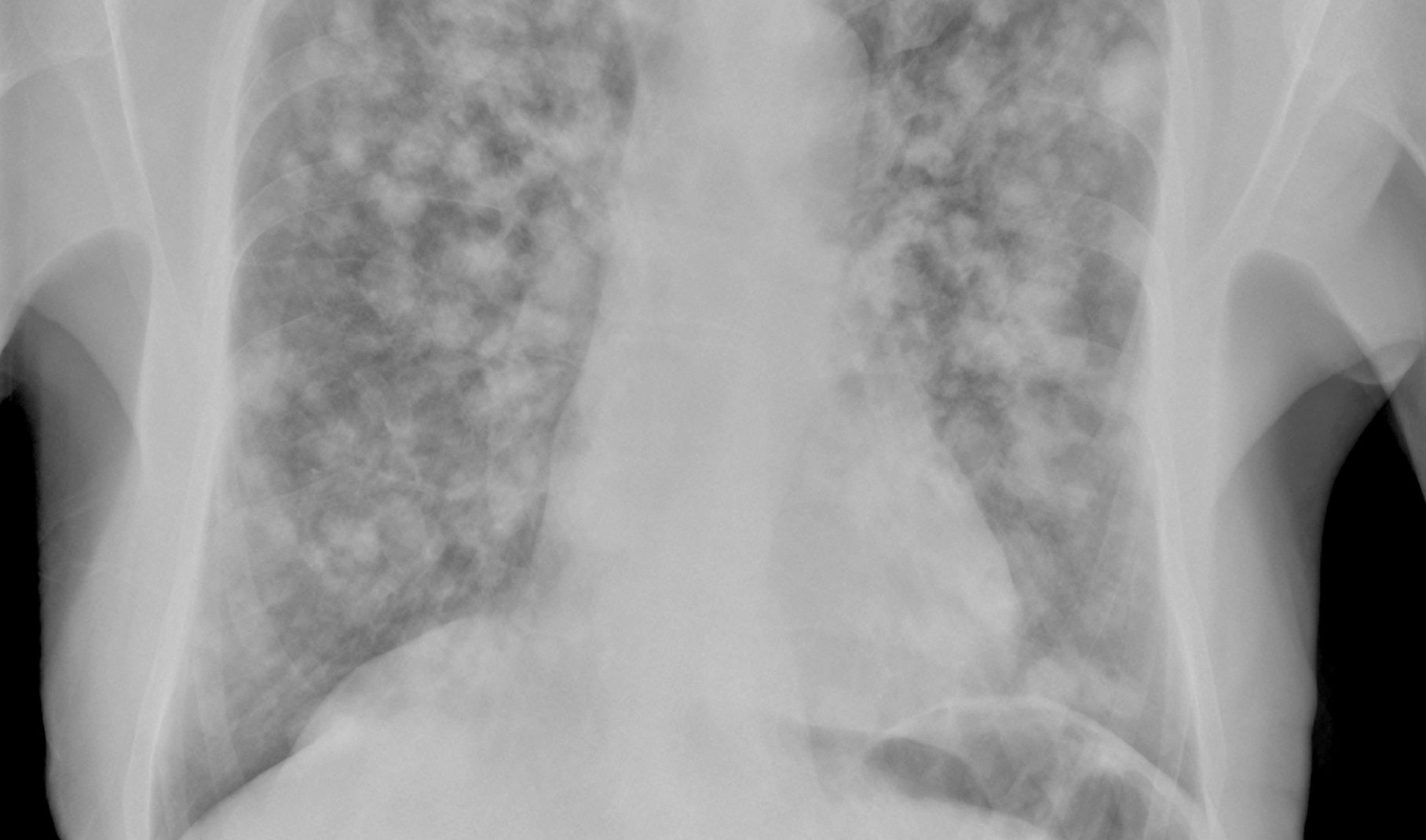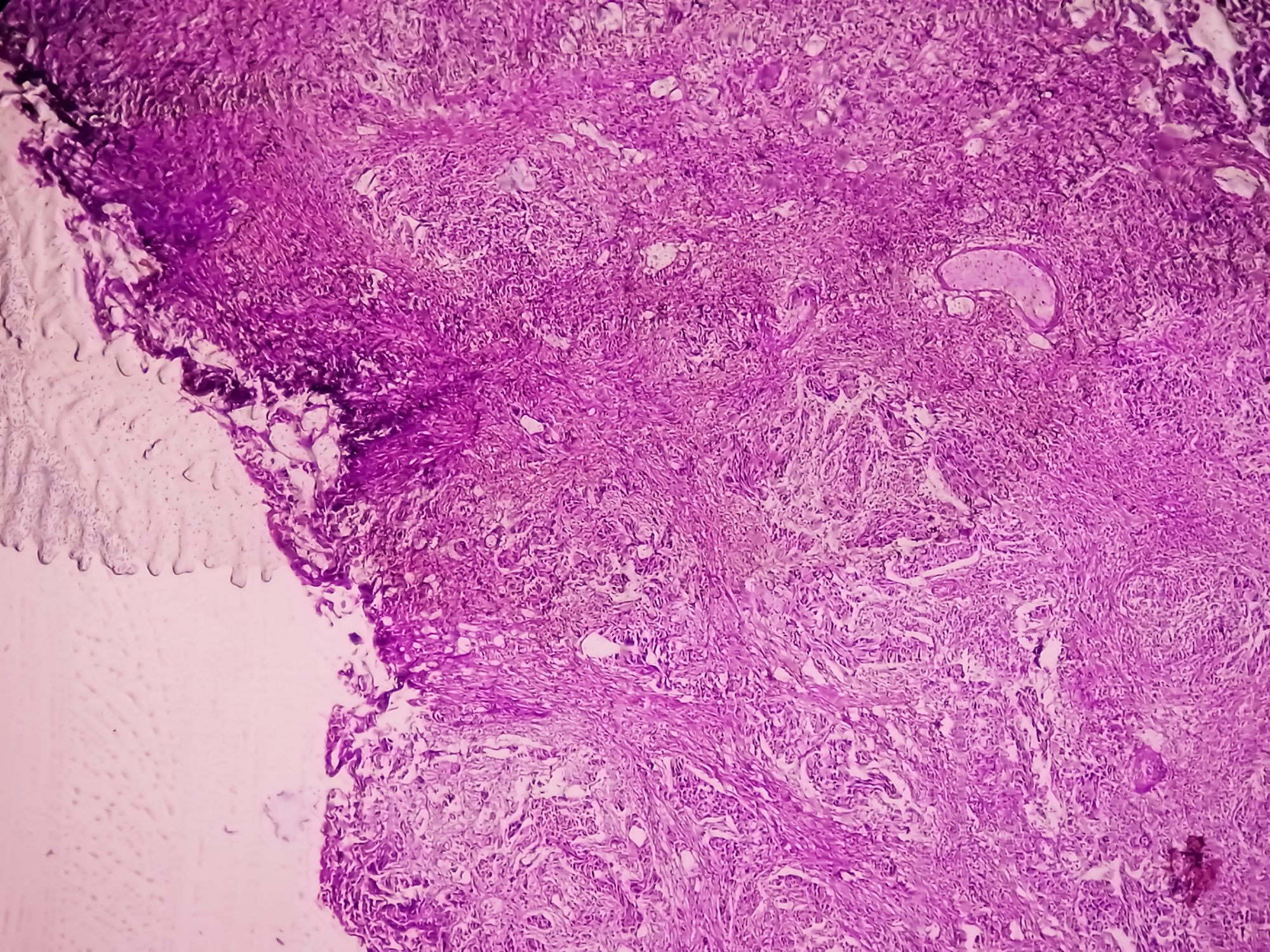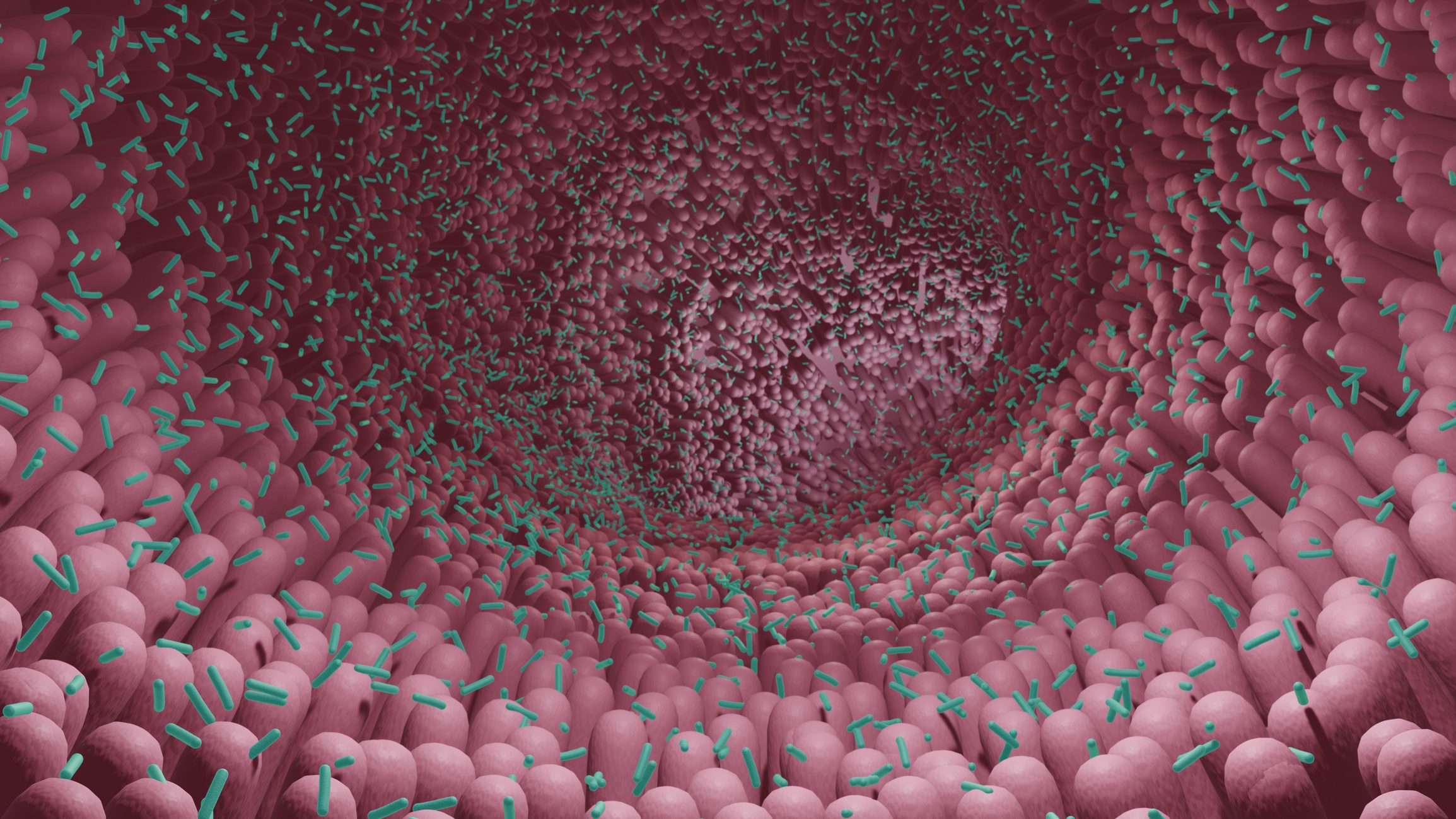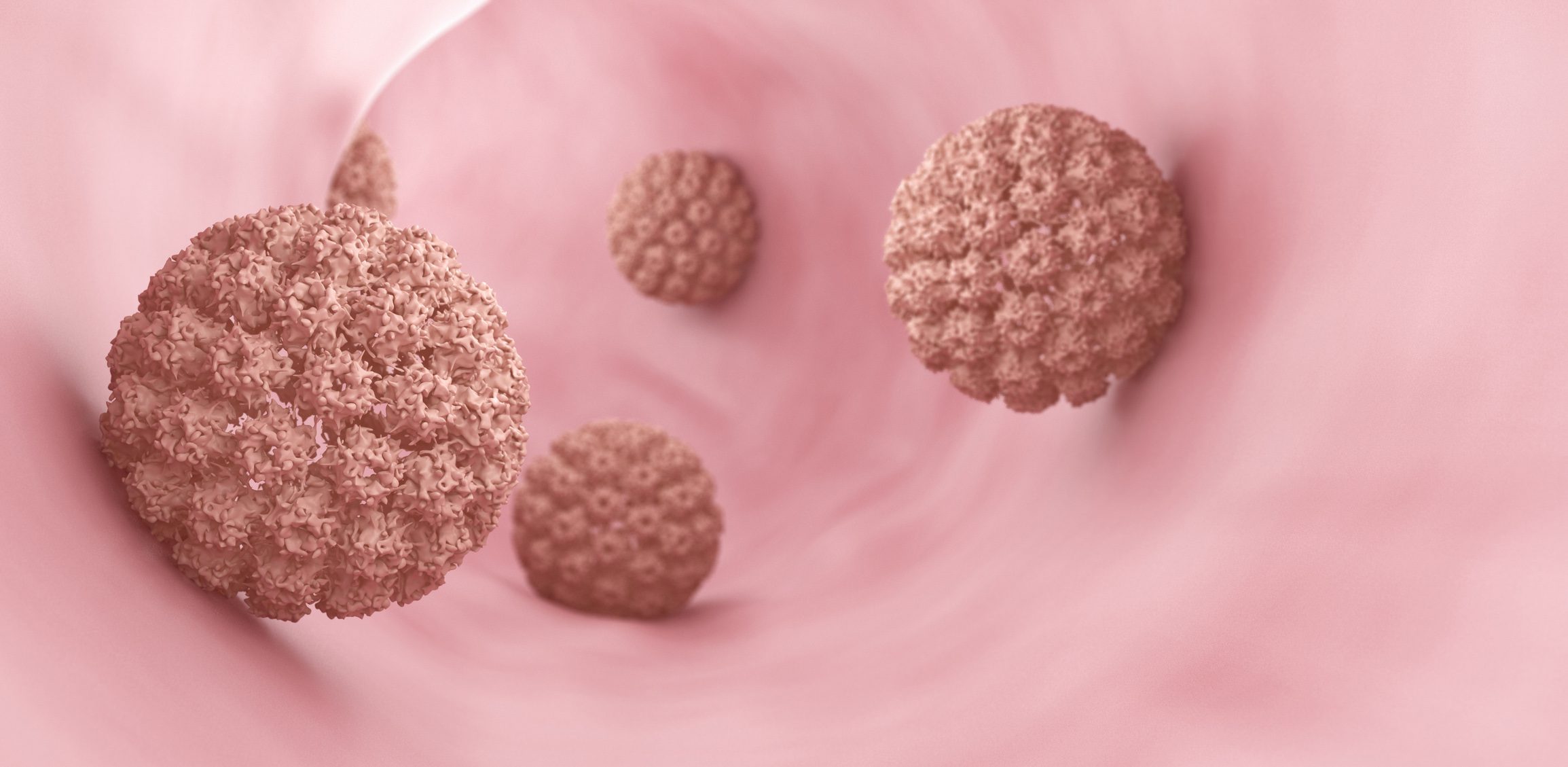Aspergillus species can cause a variety of diseases. Among them, invasive pulmonary aspergillosis (IPA) in immunocompromised patients is the most common opportunistic infection caused by molds and is characterized by acute invasion of hyphae into human tissues. Accordingly, the final proof of IPA is histological. Detection of Aspergillus on an external surface alone is not sufficient for diagnosis. If the presence of Aspergillus is demonstrated in a specimen, the correct classification of the finding guides further diagnosis and therapy.
Aspergillus species can cause a variety of diseases. Among them, invasive pulmonary aspergillosis (IPA) in immunocompromised patients is the most common opportunistic infection caused by molds and is characterized by acute invasion of hyphae into human tissues. Accordingly, the final proof of IPA is histological. Detection of Aspergillus on an external surface alone is not sufficient for diagnosis, since Aspergillus, as a ubiquitous organism, can be inhaled with the breath and also swallowed. The lungs and intestines are considered external surfaces in the above sense. If the presence of Aspergillus is demonstrated in a specimen, the correct classification of the finding guides further diagnosis and therapy.
Inhaled spores are either exhaled, removed mucociliarly, or destroyed by macrophages. If these mechanisms are prevented, the physiological defense is bypassed and very different disease patterns can develop. Chronic pulmonary aspergillosis (CPA) requires preexisting lung structural changes, such as cavernous sinuses. Spores cannot be exhaled from caverns because the airflow is chaotic. The situation is similar with impaired mucociliary clearance. In addition, pathologically dilated airways elude immune control. At the same time, ideal temperature and humidity conditions for the growth of Aspergillus fumigatus exist in such preformed cavities. Therefore, this species is the most common cause of chronic aspergillosis.
Allergic bronchopulmonary aspergillosis (ABPA) should be distinguished as another chronic form of progression. It is often associated with bronchiectasis. It is based on a pathological ongoing inflammatory reaction that leads to tissue damage. There is no tissue invasion by Aspergillus hyphae, but a misdirected immune defense is causative. Overall, the diagnosis and treatment of these rare diseases is complex, and registry studies may provide information on optimal strategies [1].
Epidemiology
IPA is an acute disease that occurs predominantly in the setting of immunosuppression. Very rarely, however, individuals who have inhaled a particularly high inoculum may be affected.
In contrast, a phase of pronounced immunosuppression would be typical, as is already present in the context of acute myeloid leukemia at diagnosis and is intensified by antileukemic therapy [2]. The rate of patients with invasive aspergillosis was as high as 24% before the introduction of systemic prophylaxis [3]. Antifungal prophylaxis reduced the rate very significantly. The strongest predisposing factor is neutropenia, so patients with myelodysplastic syndrome are also at high risk for aspergillosis. Adult patients with acute lymphoblastic leukemia are also at substantial risk, with a rate of invasive pulmonary mycoses of 13%. However, not all intensive therapies of hematologic malignancies are associated with invasive aspergillosis [4]. Thus, autologous hematopoietic stem cell transplantation does not predispose to multiple myeloma and lymphoma therapy and the rate is less than 1%. The cause is likely to be the easily controllable short neutropenia duration. In contrast, invasive aspergillosis is common in allogeneic stem cell transplantation. Although neutropenia may also be more short-lived than in other high-risk groups, drug immunosuppression comes into play and is given for weeks and months and sometimes years [2].
In patients receiving intensive care, viral pneumonias and viral tracheitis pave the way for aspergilloses. Thus, severe COVID-19 leads to aspergillosis in up to 22% [5]. For patients with influenza pneumonia requiring intensive care, this association has long been known and was recently confirmed in a Swiss cohort study. In this study, preexisting bronchial asthma increased the risk of influenza-associated pulmonary aspergillosis (IAPA) to 17%. The extent to which pneumonia resulting from infection with other viruses, such as respiratory syncytial virus (RSV) or human metapneumovirus (hMPV), promotes aspergillosis is currently unknown. There is an association in immunosuppressed patients, but it has not yet been shown for non-immunosuppressed patients. However, infections caused by viruses for which no specific therapy is available are currently underdiagnosed. Aspergillus is also a potential pathogen for other patient groups. These include recipients of solid organ transplants, especially after lung transplantation (Table 1) .
If IPA is suspected, differentiation from mucormycosis is necessary. The standard antifungal agents against aspergillosis are only partially effective against the pathogens of mucormycosis. To make matters worse, mixed infections occur. These are explained by the fact that the pathogens of mucormycosis are also absorbed per inhalationem. The upper and lower respiratory tract are also the target organs for these. The incidence of mixed infections varies regionally and is reported to be as high as 30%. This risk depends on environmental factors. It is determined by exposure to spores. From the occurrence of earth dusts to the maintenance of air conditioning systems, many individual factors have been described [6].
Diagnostics
In immunosuppressed patients, the differential diagnosis of IPA should definitely be considered in an extended diagnostic work-up. The growing number of immunocompromised, as well as the increasing use of antifungal drugs in medicine, veterinary medicine and agriculture, promotes the growth of resistance and thus the selection of more aggressive, multiresistant mold species and azole-resistant Aspergilli.
Appropriate diagnostic testing should be initiated especially in patients with persistent or recurrent neutropenic fever >72 hours that does not respond to antibiotics or who are otherwise under severe immunosuppression. Other clinical clues include nonspecific, often mild respiratory symptoms such as productive or nonproductive cough, pleuritic discomfort, mild dyspnea, and hemoptysis. The latter should already be considered a warning sign, because pulmonary hemorrhage due to invasive fungal growth is a common fatal complication of invasive mycoses; however, hemoptysis can also occur in the early stages of IPA or in sinusoidal or tracheal infestation. Expeditious, interdisciplinary collaboration is essential in the diagnosis of IPA. Admission – if not already treated as an inpatient – should be made in case of high-grade suspicion in the above-mentioned syndromes.
Radiology
Low-dose computed tomography of the thorax should be performed as the primary diagnostic test – also to differentiate lobar pneumonia or atypical pneumonia in immunosuppression. This is also suitable for the more elective diagnosis of ABPA and CPA. A chest X-ray examination is not useful. In this case, infiltrates suggestive of pulmonary aspergillosis usually cannot be clearly identified. The diagnosis should be made by a radiologist experienced with invasive mycoses in order to achieve the greatest possible diagnostic certainty; a high degree of examiner dependence has been noted in the diagnosis of IPA despite precise examination techniques. In severely immunosuppressed patients with persistent febrile neutropenia, PET-CT scanning may be performed to rule out or detect further organ involvement and other infectious foci, if available. Other infectious differential diagnoses of pulmonary CT findings and CT-graphic signs of CPA and ABPA will not be discussed in detail here.
On CT thorax, several signs may indicate invasive mycosis as defined by the EORTC/MSG [7]. If CT with angiography is performed, evidence of angio-invasive growth may already be detected here (“vessel occlusion sign”), which is associated with a high risk of fatal intrapulmonary hemorrhage in patients with IPA. Nonspecific signs include milky glass infiltrates and roundish infiltrates. Nodular lesions with surrounding milky glass infiltrate (=”halo”) are considered more specific, Fig. 1A). The latter may be an incipient sign of invasive growth and stands as a morphologic correlate for hemorrhage surrounding the infiltrate, so the halo is more pronounced, especially in thrombopenic patients in hematology. However, there are many other differential diagnoses such as other infectious agents of the bacterial and parasitic spectrum as well as malignancies, lymphomas or metastases. Another more specific CT graphic sign is a cavity caused by invasive growth and displacement of vital tissue by fungal hyphae (Fig. 1B) . The differential diagnosis in this case would be the presence of pulmonary tuberculosis, so that an unconditional clinical correlation must be made here as well. In the further course of invasive aspergillosis and especially under effective antifungal therapy, the so-called “air crescent sign” often appears, which is often a sickle-shaped formation within a cavity. (Fig. 1C). Morphologically, this is usually a regressing infiltrate that now leaves a cavity after previous invasiveness. In addition, wedge-shaped or segmental consolidation may occur. It is important to understand that the absence of such infiltrates or nonspecific infiltrates by no means excludes IPA [7]. Other fungal pathogens sometimes have other pulmonary manifestations and can therefore already substantiate a suspected diagnosis on CT; these include in particular the already mentioned mucormycosis (“inverse halo sign”) or abscessing metastases as manifestations of bloodstream infections by yeasts such as Candida spp., which themselves do not usually cause pneumonia. If invasive pulmonary mycosis is still suspected, a bronchoalveolar lavage (BAL) of the area identified on CT should be performed and multiple samples should be preserved for shipment to microbiology, molecular biology, serology and pathology. Pulmonary biopsy should be performed if the bronchial system is abnormal on BAL or mold is already macroscopically visible. In hematology, this is often not possible due to severe thrombocytopenia, but should be evaluated in any case.
Microbiology
Microbiological detection of Aspergillus spp. is based on specific procedures that are not identical to the test methods used for the detection of bacteria. Therefore, the microbiology laboratory must be notified of suspected Aspergillus pneumonia so that appropriate processing of the specimen can be performed.
The detection of Aspergillus spp. in patient samples that do not originate from a primary sterile compartment must always be interpreted with care and in the context of all available findings. Aspergillus spp. are ubiquitous environmental pathogens that are regularly detected even without clinical relevance. Instead, the detection may reflect transient colonization or represent environmental contamination. The latter must be taken into account especially in the case of highly sensitive nucleic acid detection by PCR, because this method not only detects vital aspergilli but also nucleic acid residues of dead pathogens.
Microscopy of primary samples: While routine Gram staining is well suited for microscopic detection of bacteria or even Candida spp. it is not recommended for molds. Fungal filaments (hyphae) of Aspergillus spp. and other molds can be better visualized with the aid of optical brighteners ( e.g. Calcofluor-White) (Fig. 2) .Aspergillus hyphae are narrow (3-6 µm) and exhibit regular septation; branching is usually acute-angled. However, it must be emphasized that reliable identification of molds at the genus or species level is usually not possible with this method, since microscopic identification relies on formation of characteristic fruiting forms (sporulation) under standardized culture conditions. The sensitivity of microscopic examination is unsatisfactory and is approximately 50% at best for invasive aspergillosis [8].
Cultural fungal detection: The fungal culture must be explicitly requested in the laboratory, since special culture media (for example, Sabouraud glucose agar, malt agar) are used and the incubation temperature and time differ from that of the standard bacterial culture. The rate of growth is influenced by the quality and volume of the specimen material, by the suitability of the culture media and incubation conditions used, and by specimen pretreatment and antifungal therapy of the patient. Despite adapted growing conditions, cultural mold detection is difficult and less sensitive than bacterial culture. Nevertheless, it should not be dispensed with, as cultural cultivation allows precise identification of Aspergillus spp. Traditionally, this is done on the basis of macroscopic and microscopic features (Figs. 3 and 4) . Sequence analysis of specific genes, such as the β-tubulin gene, can also be used to identify strains that do not develop typical morphological characteristics. In addition, discrimination of very closely related species (“siblings”) or discrimination within species complexes is possible. Accurate species diagnosis may influence the selection of antifungal therapy, as some Aspergillus speciesexhibit intrinsic resistance, e.g., A. lentulus, a close relative of A. fumigatus . Furthermore, susceptibility testing can be performed with cultured Aspergillus strains to detect acquired resistance. Phenotypic susceptibility testing with the reference method (broth microdilution) is laborious and established only in specialized laboratories. However, it is possible to obtain an initial indication of resistance via screening procedures using selective nutrient media spiked with antifungal agents [8].
Other detection methods: Several commercial PCR test systems are now available for detection and identification of Aspergillus spp. directly from the patient sample. Even if false-positive findings occur, the method is a useful supplement to conventional mycological diagnostics. With the detection of cell wall components, additional culture-independent assay methods are available. Galactomannan (“Aspergillus antigen”) can be determined from serum and bronchoalveolar lavage, the less specific 1,3-β-D-glucan only from serum. The significance of these biomarkers depends, among other things, on the patient population studied and the reproducibility of a positive reading [8].
Pathology
Unless a definitive diagnosis can be made from the diagnostic workup and materials obtained thus far, material should again be obtained by BAL and a biopsy of a suspicious focus should be performed.
In the histopathological, microscopic examination, fungal hyphae can already be seen in the HE stain; their invasive growth is evidential for the presence of invasive pulmonary aspergillosis – especially in immunosuppressed patients – and excludes colonization. In the extended histopathological diagnostics, a staining according to Gomorri-Grocott (silver staining) for the clear identification of mold hyphae and their branching should also be aimed for, as well as a measurement of the hyphal width to exclude other mold species such as the already mentioned Mucorales, Fusarium spp. or rarer molds as the causative agent. Molecular diagnostics via PCR can also be performed subsequently from the histology. Consultation with the National Reference Center in Jena is already possible for diagnostic purposes. In addition, centers of excellence of the European Confederation of Medical Mycology (ECMM) advise treating colleagues on the selection of targeted diagnostics.
Therapy
Therapy of IPA is complex and requires prolonged administration of antifungal agents, close monitoring for response and toxicity, and close discussion with thoracic surgery. Various therapeutic approaches have been established.
Prophylaxis: To avoid mold infections, preventive measures should be taken in the home environment of severely immunosuppressed individuals. Potential exposure exists from houseplants, compost piles, gardening, poorly maintained vents, air conditioners, and plumbing. These sources should be avoided; if this is not possible, personal protective equipment including gloves and mouth/nose protection should be worn. For prophylaxis of superficial colonization with pathogens from the mycological spectrum, especially of the mucous membranes, which may show dysbiosis due to antibiotic and drug exposure, local mouth rinses (amphotericin B based) and nourishing mucosal creams/solutions can be applied. However, there is no evidence for the reduction of invasive mycoses. A so-called “low-germ” diet is now not considered beneficial for prophylaxis of mycotic-spectrum infections even in severe immunosuppression
In certain at-risk populations, primary antifungal prophylaxis is indicated to reduce invasive mycoses, especially candidemia and IPA. These include in particular patients with acute leukemias, especially AML, as well as patients after allogeneic stem cell transplantation and lung transplantation. Drug prophylaxis should then be given with a mold-active triazole (e.g., posaconazole); in patients with AML, this has even been shown to reduce all-cause mortality [9].
Because of potential drug interactions due to inhibition of the cytochrome p450 (CYP3A4) enzyme pathway by triazoles, echinocandins or triazoles with less potent CYP3A4 inhibition (fluconazole, not mold active) are also used here when calcineurin inhibitors are administered concomitantly. In high-risk patients who cannot receive systemic prophylaxis with a triazole for this reason (e.g., ALL when given vinca alkaloids), regular (2-3×/week) monitoring of serum galactomannan may be performed for surveillance to detect early increases. Another growing group is patients with hematologic disorders, such as AML, on oral therapy tyrosine kinase inhibitors or similar molecularly targeted agents. Drug prophylaxis is sometimes indicated here as well, and attention should be paid to potential drug interactions and side effects of oncologic medication in the primary care setting as well [10].
Preemptive and empirical therapy: In addition to the primary prophylactic administration of antifungal agents, this can also be carried out empirically or preemptively. In immunocompromised patients with or without neutropenia and antibiotic-refractory fever for several days, purely empiric administration of an antifungal agent, often an echinocandin or azole – without microbiological evidence of invasive mycosis is not uncommon in clinical practice. If empiric therapy is given to patients on antifungal prophylaxis, a change of class is recommended, often to liposomal amphotericin B. All three antifungal classes are approved for empiric therapy in febrile neutropenia. It is important to note that this approach is associated with a higher rate of side effects and higher costs than, for example, the use of a single-agent therapy. a preemptive approach. This refers to the administration of antifungal agents to high-risk patients with appropriate clinical symptoms and with clear evidence of invasive mycosis. These may include fungal infiltrates on CT thorax or positive biomarker monitoring (e.g., galactomannan). In a prospective study, this therapeutic approach was evaluated as non-inferior to empirical antifungal therapy with respect to the endpoint of survival [12].
Targeted therapy: once invasive pulmonary aspergillosis is proven, targeted antifungal therapy should be given. Usually, due to the disease burden of the patient population and the high morbidity and mortality, initial therapy is provided by an IPA in the inpatient setting.
Three subtance classes are available for the treatment of invasive aspergillosis. Standard therapy consists of oral or intravenous administration of a triazole, such as voriconazole, posaconazole, or isavuconazole. Fluconazole is not effective against mold. Liposomal amphotericin B is also approved for the treatment of IPA. Echinocandins (anidulafungin, caspofungin, micafungin) can be administered as second-line therapy in case of non-response or intolerance of previous therapy or as combination partners [2].
Triazoles offer the option of early oral therapy after initial initiation of intravenous therapy. All three triazoles mentioned above require a saturation dose on days 1 and 2 of therapy, after which voriconazole is administered twice daily, and isavuconazole and posaconazole are each administered once daily. In addition to the tablet form, posaconazole is also available as an oral suspension to be administered 3 times daily, but with markedly variable pharmacokinetics.
With regard to adverse drug reactions, triazoles show gastrointestinal effects (nausea, vomiting, diarrhea) and, in particular, hepatotoxicity and QTc time prolongation. However, with isavuconazole, a shortening of the QTc interval has also been described in studies. Cutaneous (exanthema) and neurological (paresthesias, neuropathies, dizziness) side effects have also been rarely described for posaconazole. Voriconazole has also shown an increased risk of developing squamous cell carcinoma with prolonged administration, in addition to specific neuro-psychiatric side effects such as changes in color vision, hallucinations, and encephalopathy.
Liposomal amphotericin B is available intravenously and should be administered at a dosage of 3 mg/kg body weight once daily. Due to hypokalemia, infusion reactions, and nephrotoxicity, administration should be done exclusively in an inpatient setting. Non-liposomal forms of amphotericin B should not be administered nowadays due to unacceptable toxicity.
Echinocandins (anidulafungin, caspofungin, micafungin) can also only be administered intravenously to date. They should rather be used as a combination partner with an azole in severe infections or in case of non-response to an IPA. The administration takes place once a day. A new echinocandin, Rezafungin,which has been approved for once-weekly administration in the United States since 2023, may simplify long-term therapy. Other new orally available compounds such as Ibrexafungerp and Olorofim represent promising future therapeutic options.
Therapeutic drug monitoring (TDM) with target levels of 1.0-5.5 mg/dl is recommended by high-level evidence guidelines under voriconazole because of its pronounced adverse effects correlated with plasma levels.
The duration of IPA therapy depends on the clinical and radiological response as well as the immune status of the treated patient. As a rule, this should be administered over at least four to six weeks; in patients under ongoing immunosuppression, the duration of therapy can be extended months and switched to secondary prophylaxis in the course of treatment.
Clinical and radiological response should be monitored closely. Clinical symptoms should regress after only a few days. However, in cases of marked infestation with angioinvasion, these may be prolonged and become clinically apparent as hemoptysis, especially if the infiltrates decrease with antifungal therapy. CT thoraces to assess infiltrate response should be performed at days 7, 14, and 28 after diagnosis, and beyond if needed [2].
For infections refractory under continued immunosuppression and localized (e.g., one lobe of the lung), surgical resection of the ongoing focus of infection should be evaluated. Centers of Excellence of the European Confederation of Medical Mycology (ECMM) are certified in the diagnosis and therapy of mycoses, advise treating colleagues on the selection of targeted diagnostics, selection and management of therapy, and are available to evaluate inclusion in a clinical trial. ECMM experts have developed “EQUAL scores” for various entities of invasive mycoses, which weight current guideline recommendations for diagnosis and therapy on the basis of a point value and thus make them measurable. These recommendations have been validated in prospective studies [13].
EQUAL Score Cards are available as handy kittel pocket formats and can be accessed free of charge in many languages at www.ecmm.info/equal-scores. A summary of the EQUAL score Aspergillus is shown in Table 2 [13]. In summary, IPA is a serious infectious disease in immunocompromised patients with high mortality, which requires rapid, targeted, multidisciplinary collaboration and a high degree of expertise in diagnosis and therapy. Guidelines and simplified pocket cards (EQUAL scores) from the microbiological-infectious disease societies are available and can assist in this regard.
Take-Home Messages
- In immunocompromised patients with unclear fever and/or respiratory syndromes, invasive mycosis, especially pulmonary aspergillosis as the most common entity, should definitely be considered early in the diagnostic selection process.
- Diagnosis is interdisciplinary and includes CT thorax, where evidence of IPA may be detected; serology with Aspergillus antigen (=galactomannan); and broncho-alveolar lavage with shipment for culture, pan-fungal and Aspergillus-specific PCR, and galactomannan.
- Early initiation of therapy for invasive pulmonary aspergillosis is
associated with better survival and should therefore be performed with a mold-active triazole or liposomal amphotericin B when highly suspected and at the latest when positive diagnostics are available.
Literature:
- Seidel D, Durán Graeff LA, Vehreschild MJGT, et al.: FungiScope™ -Global Emerging Fungal Infection Registry. Mycoses 2017; 60(8): 508–516; doi: 10.1111/myc.12631.
- Ullmann AJ, Aguado JM, Arikan-Akdagli S, et al.: Diagnosis and management of Aspergillus diseases: executive summary of the 2017 ESCMID-ECMM-ERS guideline. Clin Microbiol Infect 2018; 24: e1–e38; doi: 10.1016/j.cmi.2018.01.002.
- Maschmeyer G, Haas A, Cornely OA: Invasive aspergillosis: epidemiology, diagnosis and management in immunocompromised patients. Drugs 2007; 67(11): 1567–1601; doi: 10.2165/00003495-200767110-00004.
- Ruhnke M, Cornely OA, Schmidt-Hieber M, et al.: Treatment of invasive fungal diseases in cancer patients-Revised 2019 Recommendations of the Infectious Diseases Working Party (AGIHO) of the German Society of Hematology and Oncology (DGHO). Mycoses 2020; 63(7): 653–682; doi: 10.1111/myc.13082.
- Koehler P, Bassetti M, Chakrabarti A, et al.: Defining and managing COVID-19-associated pulmonary aspergillosis: the 2020 ECMM/ISHAM consensus criteria for research and clinical guidance. Lancet Infect Dis 2021; 21(6): e149–e162; doi: 10.1016/S1473-3099(20)30847-1.
- Hoenigl M, Salmanton-García J, Walsh TJ, et al.: Global guideline for the diagnosis and management of rare mould infections: an initiative of the European Confederation of Medical Mycology in cooperation with the International Society for Human and Animal Mycology and the American Society for Microbiology. Lancet Infect Dis 2021; 21(8): e246–e257; doi: 10.1016/S1473-3099(20)30784-2.
- Donnelly JP, Chen SC, Kauffman CA, et al.: Revision and Update of the Consensus Definitions of Invasive Fungal Disease From the European Organization for Research and Treatment of Cancer and the Mycoses Study Group Education and Research Consortium. Clin Infect Dis 2020; 71(6): 1367–1376; doi: 10.1093/cid/ciz1008.
- Haase G, Hamprecht A, Held J, et al.: MIQ 14–15/2021: Mikrobiologisch-infektiologische Qualitätsstandards (MiQ): Pilzinfektionen Teil I und II. Elsevier-Verlag, München 2021 Podbielski A, Abele-Horn M, Becker K, Kniehl E, Russmann H, Schubert S, Zimmermann S (Hrgs.).
- Stemler J, Mellinghoff SC, Khodamoradi Y: Primary prophylaxis of invasive fungal diseases in patients with haematological malignancies: 2022 update of the recommendations of the Infectious Diseases Working Party (AGIHO) of the German Society for Haematology and Medical Oncology (DGHO). J Antimicrob Chemother 2023, in press; doi: 10.1093/jac/dkad143.
- Stemler J, de Jonge N, Skoetz N, et al.: Antifungal prophylaxis in adult patients with acute myeloid leukaemia treated with novel targeted therapies: a systematic review and expert consensus recommendation from the European Hematology Association. Lancet Haematol 2022; 9(5): e361–e373;
doi: 10.1016/S2352-3026(22)00073-4. - Sprute R, Nacov JA, Neofytos D, et al.: Antifungal prophylaxis and pre-emptive therapy: When and how? Molecular Aspects of Medicine 2023; 92: 101190; doi: 10.1016/j.mam.2023.101190.
- Maertens J, Lodewyck T, Donnelly JP, et al.: Empiric vs Preemptive Antifungal Strategy in High-Risk Neutropenic Patients on Fluconazole Prophylaxis: A Randomized Trial of the European Organization for Research and Treatment of Cancer. Clin Infect Dis 2023; 76(4): 674–682; doi: 10.1093/cid/ciac623.
- Cornely OA, Koehler P, Arenz D, C Mellinghoff S: EQUAL Aspergillosis Score 2018: An ECMM score derived from current guidelines to measure QUALity of the clinical management of invasive pulmonary aspergillosis. Mycoses 2018; 61(11): 833–836; doi: 10.1111/myc.12820.
HAUSARZT PRAXIS 2023; 18(6): 12–19

















